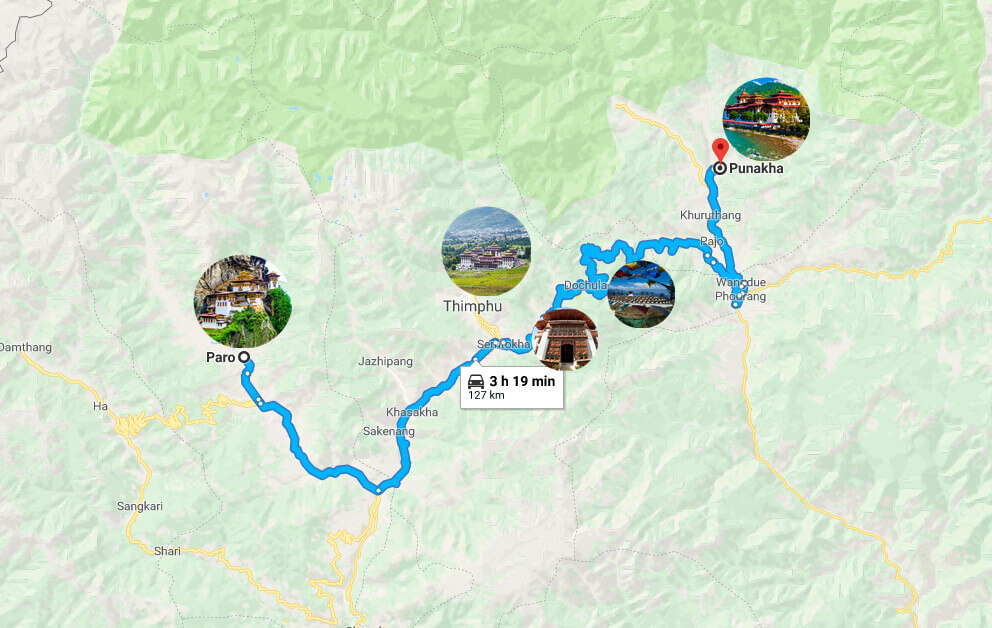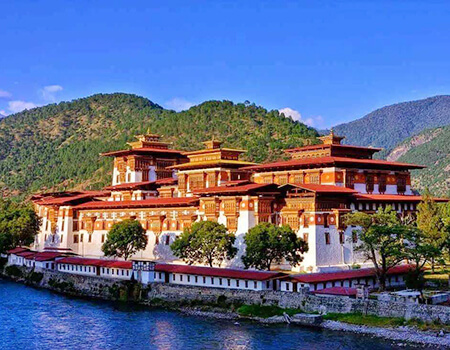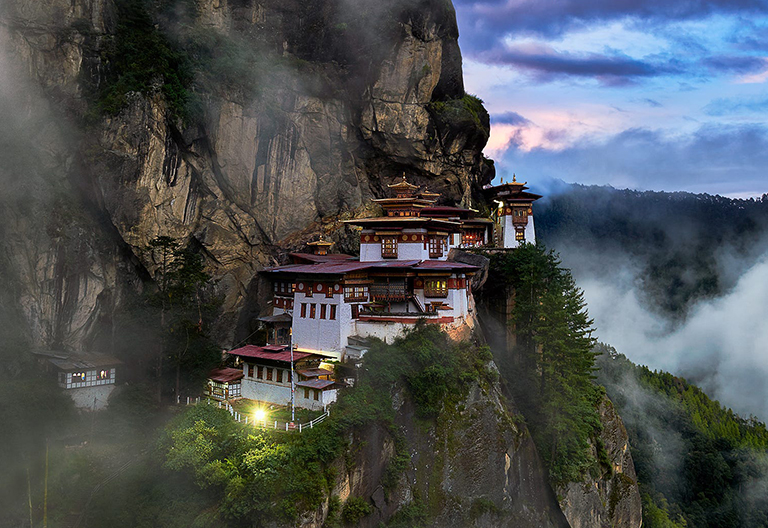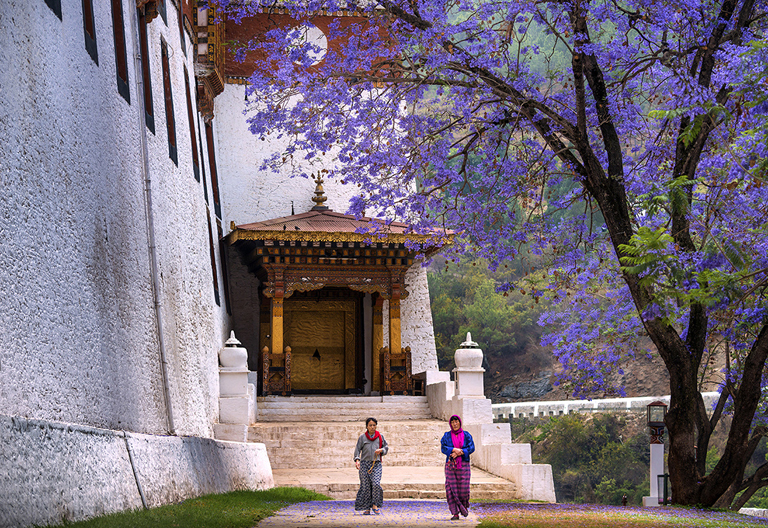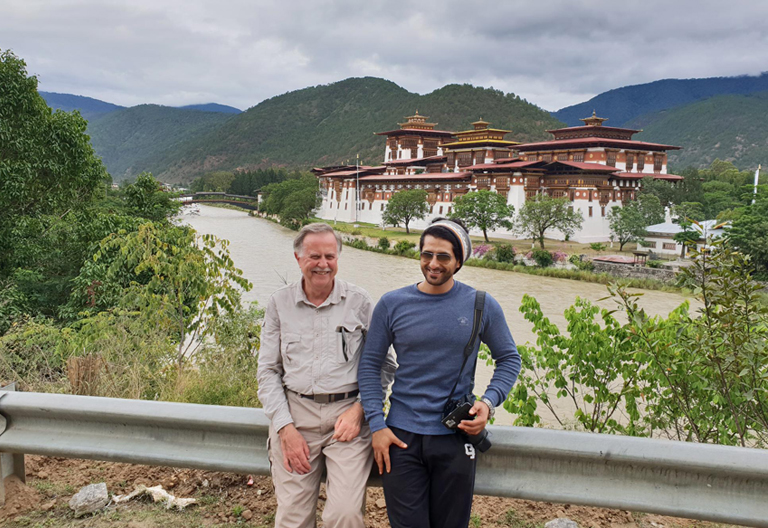
Punakha - Attractions, Traffic, Weather, Hotels, Maps
Punakha is a well-known district in Western Bhutan for the most beautiful and second oldest Punakha Dzong. It was the capital of Bhutan for over 300 years before the government moved it to Thimphu in 1955, where is about 70 km away for 2.5 hours’ driving. Located at an average elevation of 1,200 m along the Mochhu River and Puchhu River (two of the most important rivers in Bhutan), Punakha enjoys a moderate weather and climate, which is suitable for living and rice farming. Therefore, the former seat of government - Punakha Dzong serves as the winter residency for the Central Monastic Body. With a short distance from capital Thimphu, Punakha proves itself a must-visit destination with brilliant cultural legacy, historical legend and appealing countryside landscape.
Ancient Capital Plus the Most Beautiful Dzong
The earliest history of capital role of Punakha dated back to 1637. Later in 1907, the first king of Bhutan got his coronation ceremony in Punakha and remained it as the capital city, and thence Punakha opened a modern chapter in the history of Bhutan. In 1953, the first national assembly was hold here by the 3rd King of Bhutan who also implemented the first five-year plan, and promoted GNH (Gross National Happiness) and many significant reforms. As the best testimony of Bhutan’s major development, the current 5th king of Bhutan hosted his grand wedding in the beautiful Punakha Dzong in 2011. This beautiful landmark - Punakha Dzong is the best and most beautiful site to explore the brilliant cultural legacy and historical relic of Punakha, because it witnessed the tough past as the seat of government.
Top Places to Visit in Punakha
History moves on, plenty of heritages were left. As the previous capital of Bhutan, Punakha preserves many historical treasures and religious relics, as well as modern adventures. In Punakha, you can soak up the atmosphere of rich history and amazing culture, enjoy stunning natural views, experience an adventure trip etc. Time gets slower and more diverting if you pay a visit to the picturesqure Punakha Dzong, Chimi Lhakhang Temple and Khamsum Yulley Namgyal Chorten, feast your eyes at Dochula Pass with Himalayan views and refreshing rustic fields, and record an unusual trip on a river raft with your family.

-
Punakha Dzong
Type: History, Religion, Culture
Recommended Length of Visit: 2~4 hours
Located at the juncture of Phochhu & Mochhu Rivers, Punakha Dzong is the second oldest and second largest dzong, and the most beautiful dzong in Bhutan. The best photography season is the bright purple Jacaranda blossom between April and June in spring. Once served as the ancient capital untill 1955, it is the winter residence of the Central Monastic Body and still enjoys high status in religion and politics nationwide. The fortress itself is an excellent Bhutanese architecture with lots of Buddhist legacy and cultural relics in delightful look. It is extremely beautiful when the white walls, monks worn red robes are reflected against the shining sunshine.

-
Punakha River Rafting
Type: Sport, Adventure
Recommended Length of Visit: 1~2 hours
Without a rafting by beautiful Punakha Dzong, your Punakha trip would be incomplete. The rafting experience on Mochhu River (female river) and Pochhu River (male river) is a popular activity for families with kids and young adventures. Both safety and fun are ensured in this cool event. Remember to find an experienced and reliable agency that will provide you equipment, detailed instruction and excellent rafting guidance. Better choose a proper stream to go, for the Mochhu River (10 km) flows gentler than Pochu River (16 km), and prepare some clothes for exchange.

-
Chimi Lhakhang Temple
Type: Religion, Culture, History
Recommended Length of Visit: 1~2 hours
A walk through a beautiful village and lush green rice fields, you will see a humble bust unique temple where cute child monks learn Buddhism, women and couples pray for children and health of babies. Originally, this Temple of Fertility was built to worship the Devine Madman - Lam Drupa Kuenley, a famous Buddhist master teaching Buddhism in un-conventional ways. The blessing legend is odd but always efficacious among the Bhutanese. Your confusion about various paintings of phallus symbol on Bhutanese houses can get clear explanation from here. Better find a chance to tour a local farmhouse and visit interesting shop and enjoy fresh air around.

-
Dochula Pass
Type: Viewing Deck of Nature, History
Recommended Length of Visit: 1 hour
Reviewed as a great balcony to see the breathtaking Himalayas, Dochula Pass (alt: 3,140 m) located on the way to Punakha from Thimphu is one of the highest points in Bhutan. From there, you can see spectacular panoramic view of the Himalayan mountain range on clear days (between October to December). Except the scenic beauty, the 108 Stupas aligned on the hill nearby with colorful prayer flags is an important religious site for locals, as they were built in memory of soldiers died in war. Enjoy your cozy time in the nearby café during the stopover.

-
Khamsum Yulley Namgyal Chorten
Type: Religion & Culture
Length of Hiking: about 1 hour
Efforts to hike for 30 minutes crossing the iron Suspension Bridge, terrace fields and pray wheels will be rewarded ultimately once reach the elaborate chorten. Symbolized as a traditional Bhutanese style architecture, this majestic Chorten is the only stupa enshrining all kinds of Dharmapalas in Bhutan. Most important, all the architecture inspiration comes from the doctrines of Buddhism. On this shrine, you can sit under the Bodhi tree, mediate for a while, watch the monks, and enjoy exquisite Buddha statues and mural paintings representing Buddhist teaching and manifestation. And don’t miss the spectacular view of the whole Punakha Valley from the top.

-
Punakha Tshechu Festival
Type: Religion & Culture
Date: Mid-February or Early March (lasts 3 days)
Venue: Punakha Dzong
Punakha Tshechu same like other Tshechu Festivals in Bhutan is one of the biggest religous event to honor Guru Rimpoche (Padmasambhava), founder of Tibetan Buddhism and one of the most influential Buddhist masters. Locals, especially women will dress beautifully during the festival to watch Cham Dance (mask dance) and a huge Thangka painting with image of Padmasambhava. Other interesting activities will be held too.
How to Get to/around Punakha
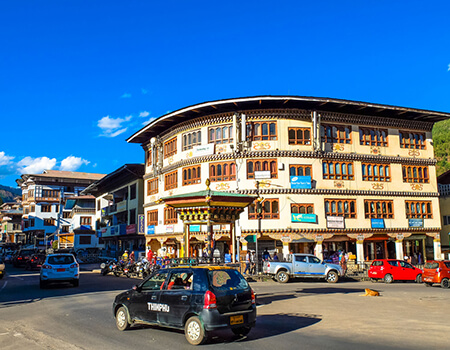
-
Currently, there is no airport located in Punakha and Paro Airport is the only international airport tourist can take flights to Bhutan. Hence, visitors are planning to visit Punakha have to fly to Paro first and then transfer to Punakha from Paro by driving.
Paro to Punakha - Punakha is located in the northeast of Paro, about 130 km by 3.5 hours’ driving. If you go straight to Punakha from Paro, you will pass Thimphu valley after about 1.5 hours’ ride and continue driving eastward to Punakha in central north Bhutan. Read more about Paro to Punakha >>
Thimphu to Punakha - Punakha is in northeast side of Thimphu. It’s a 2.5 hours' drive journey to Punakha from Thimphu with a distance of 85 km. Firstly, you will drive towards south Thimphu Valley to leave Thimphu via the Thimphu-Punakha National Highway, soon you can have great view of the Simtokha Dzong while turning to west-east road. Then you will drive upward to Dochu La Pass (3,140 m – the highest point en route) after 45 minutes’ driving from Thimphu, next continue a 1 hour & 45 minutes’ drive on descending ways to arrive in Punakha. Read more about Thimphu to Punakha >>
Best Time to Visit Punakha
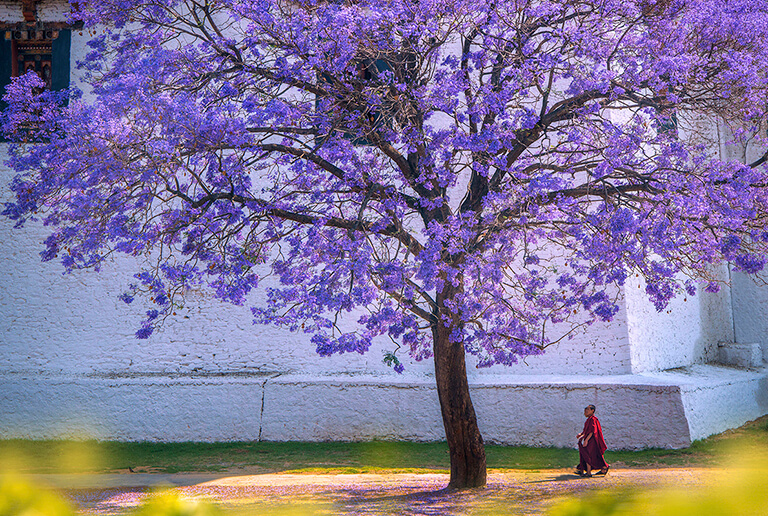
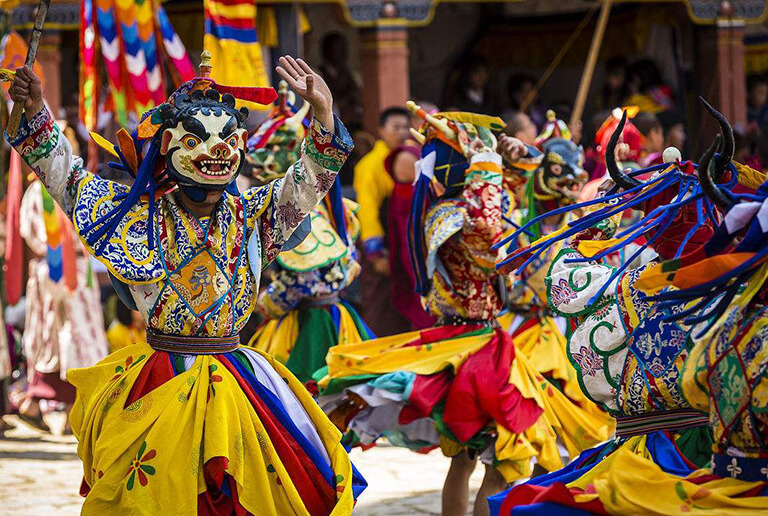
-
Located in Punakha valley with an average elevation of 1,200 m, Punakha enjoys a moderate climate feature with warm winters and hot summers. The best time to visit Punakha is from February to April and October to December, when the weather and climate is fairly mild and comfortable with more clear days. Meanwhile, Punakha hold colorful festivals during the two periods.
From February (the beginning of spring), it’s getting warmer in Punakha and other low-altitude areas. The major festival - Punakha Drubchen will be held in this period. While it’s still cold in high-altitude areas, like Paro and Bumthnag, few tourists will visit at this time. Days would turn to be humid and hot in Punakha Valley from May. For this reason, the whole Central Monastic Body will move to Thimphu Tashichho Dzong from Punakha Dzong on the first day of the 4th lunar month.
Influenced by the south Indian Ocean, summer months from June to September are the rainy season when frequent rainfalls will lead to an inconvenience and uncomfort. However, after the monsoon is over, the temperature will be moderate with more good view of the Himalayas during following autumn. Consequently, flight tickets and accommodation can be intense. Cold winter hits most high-elevation regions, it may snow, however the Punakha still keep a temperate climate (average maximum temperature: 22℃) in November and December of early winter, due to its lower altitude. Read more about Punakha Weather and Climate >>
Where to Stay - Hotels in Punakha
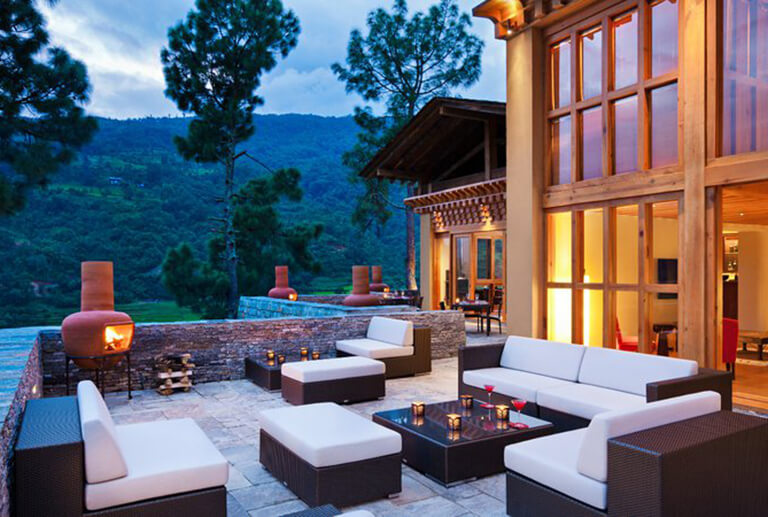

-
Accommodation in Punakha has a variety of choices to select, ranging from some fancy luxury hotels, lots of budget hotels and distinct guesthouses in traditional Bhutanese style. Rest assured that you will be fulfilled a pleasant and memorable stay with clean and comfortable rooms and considerate service from the nice hospitable Bhutanese.
Uma Resort by COMO and Amankora are the only two world-class 5-star hotels in Punakha. They are both located in serene valley, offer all luxury amenities, high-quality treatments and relaxation, excellent traditional Bhutanese cuisine and tail-made choice. Nothing to concern, you just enjoy the fantastic reviews of the valley and exceptional dinner in front of the refreshing nature and keep it a paradise dream forever.
For budget hotels in Punakha, there are quite more to introduce, so we pick up some for your reference. RKNP Green Resort is a 4 star local hotel with traditional style exterior and capacious room, lovely staff, where window view is quite picturesque. Dhensa Boutique Resort is a top-rated hillside resort designed in a modern and simple style, the great view of Punakha, tranquil atmosphere and superb cooking and more will surprise you every second you spend here. Read more about Punakha Accommodation >>
Useful Bhutan Travel Notes
- 1. How to Get a Bhutan Visa
- Except Indians, Bangladeshis and Maldivians, all foreign tourists wishing to travel to Bhutan are required to obtain Bhutan Visa Clearance Letter prior to departure. It is a single-entry visa that can only be applied by licensed Bhutanese tour operator and their international partners. If you travel with us, you only need to send us a clear scanned copy of your passport for a minimum one week visa processing. Once issued, a Visa Clearance Letter will be emailed to you for taking flights to Bhutan. After arrival in Paro Airport, the immigration officer will stamp the Bhutan Visa on your passport after checking the Visa Clearance Letter. Then you can start the dream trip in the kingdom of Bhutan.
- 2. How to Plan a Bhutan Tour
- A classic Bhutan tour usually takes about 6 days involving Paro, Thimphu and Punakha. Apart from the arrival and departure days, you get 4 full days to explore the landmarks in Bhutan - three days in the towns of Paro, Thimphu and Punakha, and another day in Taktsang Monastery (Tiger’s Nest). If you want an in-depth tour to central Bhutan, you are suggested to spend extra 4 days to Bumthang via Wangdu Phodrang and Trongsa. Many travelers prefer an overland tour in Nepal, Tibet and Bhutan to discover the Himalaya Kingdoms. If time permits, you can take a one-hour flight from Bhutan to Nepal, where you can admire the medieval architectural wonders and marvelous landscape of Himalayan Peaks. After that, take an overland driving journey to the holy city Lhasa via Mount Everest, Tibet.
- 3. How to Get to Bhutan
- There are two choices to get to Bhutan – by international flights from connected Asian countries (Nepal, India, Thailand, Singapore and Bangladesh) and by overland driving from India. Since Paro is the only international airport, all the flights to Bhutan lands on Paro. Meanwhile, there are three accessible land ports connected Bhutan and India, including Phuentsholing, Samdrup Jongkhar and Gelephu. Phuentsholing is the primary one which connects Chhukha of Bhutan and West Bengal of India. From Phuentsholing, it takes about 6 hours to drive to Paro or Thimphu. The other two ports are located in central and eastern remote area of Bhutan.
- 4. Other Destinations in Bhutan
- Apart from Punakha, there are many other destinations worthy of your visit, including Paro, Thimphu, Phobjikha, Wangdue Phodrang, Trongsa, Bumthang etc. Paro has the iconic site of Bhutan - Taktsang Monastery (Tiger's Nest Monastery) . Punakha has the most beautiful Dzong in Bhutan – Punakha Dzong. As the capital city with natural and cultural glamour, Thimphu is a must-be-visited city in Bhutan. Its National Memorial Chorten is an important holy site. Besides, there are many interesting and significant museums and institutes to catch a view of Bhutan’s rich history and culture.Extending your trip to central Bhutan, you will get amazed by the valleys with distinguished scenery and historical sites.
Most Recommended Bhutan Punakha Tour Packages
Following are some recommended Bhutan tour packages that you may be interested in. All tour packages are customizable to meet your personal requirements. You can also contact us to customize a trip if you want.
-

-

-

9 Days Bhutan In-depth Natural and Cultural Tour
Paro / Thimphu / Punakha / Phobjikha / Trongsa / Bumthang / Wangue Phodrang / Paro

